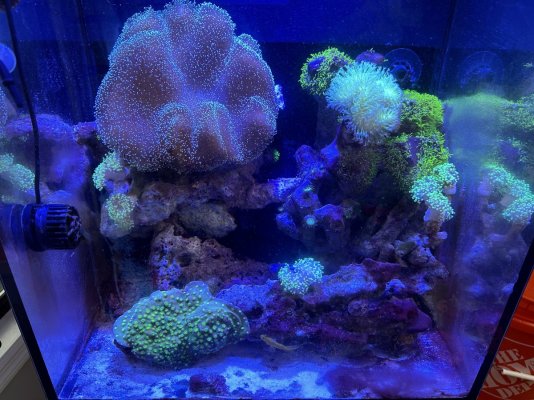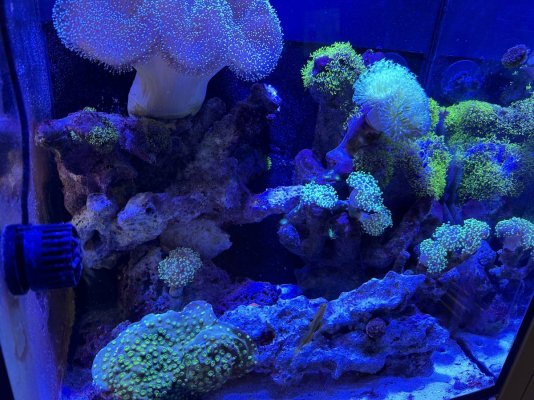Before you begin, once again, I strongly suggest you just let the tank age normally. I don't see ANY problems that isn't part of the normal reef aging cycleI’ve got hydrogen peroxide, dropper/pipette, and ~2.5G in a bucket dedicated for cleaning first test rocks (and another 5G for WC).
Looking into a brute-type container for more SW but also saw 10G tanks are pretty cheap at LFS
Navigation
Install the app
How to install the app on iOS
Follow along with the video below to see how to install our site as a web app on your home screen.
Note: This feature may not be available in some browsers.
More options
You are using an out of date browser. It may not display this or other websites correctly.
You should upgrade or use an alternative browser.
You should upgrade or use an alternative browser.
Adding sand to fight ugliness on rescue tank
- Thread starter StackTrayce
- Start date
- Tagged users None
My advice : Dont add new sand, get nassarius snails, af life source and dose nopox or probio f, let it stabalise and be patient
The way to make a nano reef live forever is to treat it like a dentist treats a mouth
hands off reefing doesn’t work for the masses it only works for the 1% who aren’t thinking in decades lifespan duration, hands off nano reefing is what the masses do that average 5 years at best.
here’s sixty pages of rip cleans. In order to track out the long term outcomes for the entrants, pick a profile from some earlier jobs

 www.reef2reef.com
www.reef2reef.com
select find all threads
then go look at their posts after the jobs for some years, find the patterns at work
when the masses enact reed dentistry and command the tank vs hope for luck, what’s the pattern outcome?
every example thread in the post is a rip clean. They may be moving homes and have no invasion, or they may be invaded and using it for that, it might be an upgrade job but the method is the same
rip cleans simply remove waste, that’s it. waste + target complexes
they refresh all reefs. I run them in mine before a problem, preventatively, not reactively
the masses wait for a problem then react with hesitancy
doing opposite of what the masses do earns a rare long lifespan where luck plays no role
notice hidden patterns: not once in nine years did we measure for ammonia afterwards (that way misreading api and Red Sea test kits caused no false panic)
there’s no bottle bac used, that’s all pure skip cycle biology with laser clear outcomes
what are the negatives people reported there? I find none, only wows
a rip clean is exactly like the part on never ending story where Atreyu must pass through the southern oracle statues, and if there’s a shred of doubt they laser zap him. Partial hesitant rinsing in fear of a crash despite what’s on file is that shred of doubt
but if you’re practiced on rock cleaning and most of the picking job is done ahead of time, and on the day of the rinse you work the sand correctly and reassemble the tank in the order shown, that’s passing through the gate with confidence and a clean boosted reef is on the other side, for any reef.
***for sure mistakes can happen. A lid might be left off and a fish jumps to its doom, or when lifting a rock it falls and lands on a coral or fish. Leaving the tank alone might be safest for the short term. But, have we looked through full invasion threads in the nuisance algae forum? What do those reefers feel like when sampling the crowd for help on the final stretch, investment on its last leg, everybody scrambling for best practices and nobody posts a resolved, logged cure? Safety in the short term was what they chose in 2022 that got them there today with a tank on its last leg. They should have acted long ago, with resolve.
one of the best ways we can test our help offer validity is to get into the nuisance algae forum and fix someone else’s tank. I don’t mean post one offer among ten in a random help thread, then move to the next with a single post among the lot
I’m meaning take over the thread and literally see something through to completion. That’s different than the safety of the passing offer, total investment in someone else’s outcome is not what the masses do.
hands off reefing doesn’t work for the masses it only works for the 1% who aren’t thinking in decades lifespan duration, hands off nano reefing is what the masses do that average 5 years at best.
here’s sixty pages of rip cleans. In order to track out the long term outcomes for the entrants, pick a profile from some earlier jobs

Official Sand Rinse and Tank Transfer thread
If you are reading this thread to cure a tank invasion from a link I sent you, we do not need to identify your type of invasion here we do not need you to test anything at anytime regarding nitrate, phosphate etc Above all, we do not need to see a microscope slide picture of your invasion at...
 www.reef2reef.com
www.reef2reef.com
select find all threads
then go look at their posts after the jobs for some years, find the patterns at work
when the masses enact reed dentistry and command the tank vs hope for luck, what’s the pattern outcome?
every example thread in the post is a rip clean. They may be moving homes and have no invasion, or they may be invaded and using it for that, it might be an upgrade job but the method is the same
rip cleans simply remove waste, that’s it. waste + target complexes
they refresh all reefs. I run them in mine before a problem, preventatively, not reactively
the masses wait for a problem then react with hesitancy
doing opposite of what the masses do earns a rare long lifespan where luck plays no role
notice hidden patterns: not once in nine years did we measure for ammonia afterwards (that way misreading api and Red Sea test kits caused no false panic)
there’s no bottle bac used, that’s all pure skip cycle biology with laser clear outcomes
what are the negatives people reported there? I find none, only wows
a rip clean is exactly like the part on never ending story where Atreyu must pass through the southern oracle statues, and if there’s a shred of doubt they laser zap him. Partial hesitant rinsing in fear of a crash despite what’s on file is that shred of doubt
but if you’re practiced on rock cleaning and most of the picking job is done ahead of time, and on the day of the rinse you work the sand correctly and reassemble the tank in the order shown, that’s passing through the gate with confidence and a clean boosted reef is on the other side, for any reef.
***for sure mistakes can happen. A lid might be left off and a fish jumps to its doom, or when lifting a rock it falls and lands on a coral or fish. Leaving the tank alone might be safest for the short term. But, have we looked through full invasion threads in the nuisance algae forum? What do those reefers feel like when sampling the crowd for help on the final stretch, investment on its last leg, everybody scrambling for best practices and nobody posts a resolved, logged cure? Safety in the short term was what they chose in 2022 that got them there today with a tank on its last leg. They should have acted long ago, with resolve.
one of the best ways we can test our help offer validity is to get into the nuisance algae forum and fix someone else’s tank. I don’t mean post one offer among ten in a random help thread, then move to the next with a single post among the lot
I’m meaning take over the thread and literally see something through to completion. That’s different than the safety of the passing offer, total investment in someone else’s outcome is not what the masses do.
Last edited:
This was a 5 year old established reef I got off fb marketplace. Wasn’t in great shape and the sand bed is patchy and dirty.Before you begin, once again, I strongly suggest you just let the tank age normally.
Moving the sand without this rinse causes advanced aging. Detractors aren't reading the linked threads to see 500 positive outcomes from taking time to de- age systems before they become invaded. They feel the method is harmful or some sort of insult by simply not clicking to read. It's good for any reef. To remove sandbed waste before an event is smart, most reefers are trained to be reactive only, hence the incredibly short lifespan of the average reef tank and the total helplessness when posting in the nuisance algae forum for reactive options.
to learn how to get past the entrained doubt about handling reef substrates and simply command them to comply is the #1 lifespan trick you can ever learn for your nano reef. being hands off, cautious, scared, not in command, is what you see in nearly any post in the nuisance algae forum.
the way you can spot a passive nano reefer is to see if their system is wrecked with algae in pics, they let it become that way by not being more active than the invasion and our training does that to them early on
we teach that interception is dangerous vs showing threads where it's not
active reefers have no wreck in photos; they post for help in reducing the activity it takes to keep the system clean...how to reduce growback but they do not post a tank completely wrecked by anything including dinos because they didn't let it become that way. they did not sit back, they're busy every day if that is what it takes.
this isn't mean, it's a reflection on the greater training reefers get that is seeded here in this thread- being instructed to do nothing is that passivity training and if your tank chooses, it'll go into advanced eutrophication like the ones we've linked for reading.
intercepting now is wisest move possible because you will see there's zero downside to it other than the few hours catch up work. large tankers can't enact these physical controls that small tanks can enact so I don't have any judgment for large tankers, they have it rough having to always work through the water and cross fingers that something will work.
a nano reefer has total access to their system and can be invasion free by will and action, no chemistry or biology tuning needed.
to learn how to get past the entrained doubt about handling reef substrates and simply command them to comply is the #1 lifespan trick you can ever learn for your nano reef. being hands off, cautious, scared, not in command, is what you see in nearly any post in the nuisance algae forum.
the way you can spot a passive nano reefer is to see if their system is wrecked with algae in pics, they let it become that way by not being more active than the invasion and our training does that to them early on
we teach that interception is dangerous vs showing threads where it's not
active reefers have no wreck in photos; they post for help in reducing the activity it takes to keep the system clean...how to reduce growback but they do not post a tank completely wrecked by anything including dinos because they didn't let it become that way. they did not sit back, they're busy every day if that is what it takes.
this isn't mean, it's a reflection on the greater training reefers get that is seeded here in this thread- being instructed to do nothing is that passivity training and if your tank chooses, it'll go into advanced eutrophication like the ones we've linked for reading.
intercepting now is wisest move possible because you will see there's zero downside to it other than the few hours catch up work. large tankers can't enact these physical controls that small tanks can enact so I don't have any judgment for large tankers, they have it rough having to always work through the water and cross fingers that something will work.
a nano reefer has total access to their system and can be invasion free by will and action, no chemistry or biology tuning needed.
Last edited:
ST study this, very important contrast to everything we've typed and prepped for your tank

 www.reef2reef.com
www.reef2reef.com
That's literally opposite of our planned outcome for your tank and is fully avoidable in every case, so it's an important study prep for rip cleaners

Zombie tank, can it be saved
I have a plan for the aiptasia on the sand. Seems like they really prefer to be in rock, so I added some rubble on top of them, and then I throw the rubble into a bucket of fresh water…rinse repeat. Im probably going to just attack all of the ones around my coral with a toothbrush. There are...
 www.reef2reef.com
www.reef2reef.com
That's literally opposite of our planned outcome for your tank and is fully avoidable in every case, so it's an important study prep for rip cleaners
Last edited:
Thanks, still doing reading of some other threads. Committed to not adding sand until all old sand is removed and rocks have gotten decent cleaning. I did one test rock, not sure if my technique is decent or not. Mostly brush off loose stuff, knife point and edge scraping on some stuff, but this rock wasn't too bad. I put 3% peroxide in a small dish and dipped paper towel and small washcloth in to dab non coral areas with peroxide. Did dip bottom of a frogspawn frag in peroxide as a test. Rinsed/swished in recently removed similar-temp tank water.
Back in tank, polyps out about the same as before on frogspawn and small patches of GSP on rock. Will try to post some pics later today.
Back in tank, polyps out about the same as before on frogspawn and small patches of GSP on rock. Will try to post some pics later today.
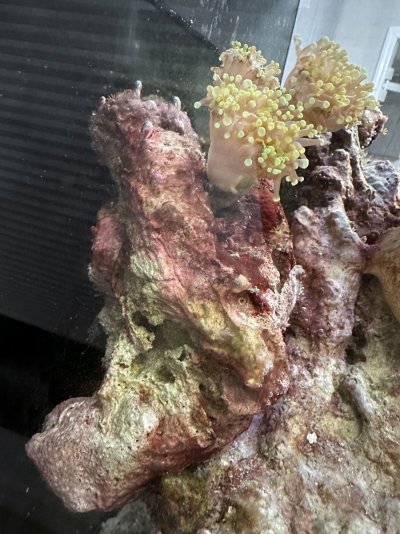
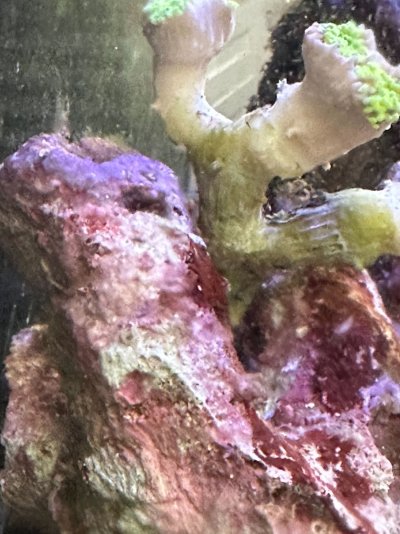
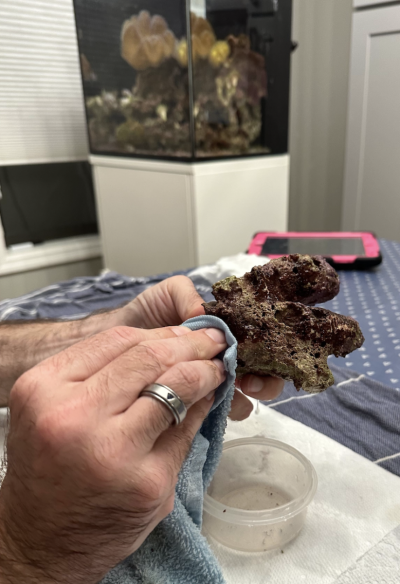
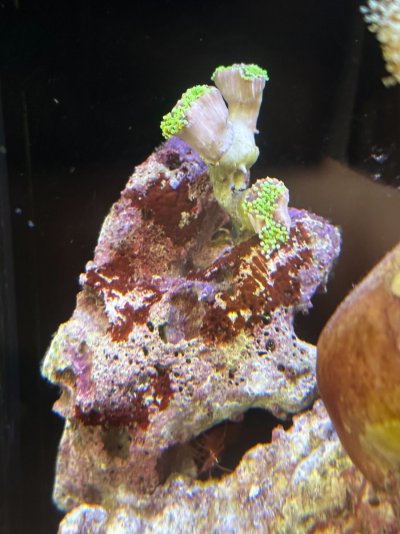
These are from Saturday. Frogspawn has more polyp extension now.
In the post scrub pic you can see I may have gone too hard on a test spot and removed coraline algae, but I'm not sure.
I'm not totally sure what to attack aggressively with a knife, I think on next rock I will just dab and scrub all non coral surfaces and only use knife to dislodge hair algae where I find it (not much compared to purple red gunk). I also rotated the rock so it is not in its original position.
Bottom of frog spawn frag that I dipped in 3% HP seems fine.
did you tap rinse the sand out/rip clean it
if you tap rinsed that sand, you have a totally rare gem we can use on 3-5 really big tank restoration threads: a start to finish skip cycle rip clean. awaiting outcome of the cliffhanger detail lol
if you tap rinsed that sand, you have a totally rare gem we can use on 3-5 really big tank restoration threads: a start to finish skip cycle rip clean. awaiting outcome of the cliffhanger detail lol
Wow, pleased to see a reply from you so soon!
I've removed a bit of gunky sand during water changes, but nothing significant recently. The sand that is in there is original sand from previous owner. Definitely still cyano on parts of sandbed and unscrubbed rocks.
I'm planning on ordering 1 or 2 bags of carib sea special grade sand and rinsing heavily, draining most/all water, removing rocks and livestock, and clearing out as much old sand as possible, then add in new sand and replace everything.
Awhile ago I read thru some of a sand rinse thread and saw mention of a method w/ a hose at bottom of a bucket, but I never gathered details. Hoping to put in an order for sand and everything I need to start rinsing this weekend.
I've removed a bit of gunky sand during water changes, but nothing significant recently. The sand that is in there is original sand from previous owner. Definitely still cyano on parts of sandbed and unscrubbed rocks.
I'm planning on ordering 1 or 2 bags of carib sea special grade sand and rinsing heavily, draining most/all water, removing rocks and livestock, and clearing out as much old sand as possible, then add in new sand and replace everything.
Awhile ago I read thru some of a sand rinse thread and saw mention of a method w/ a hose at bottom of a bucket, but I never gathered details. Hoping to put in an order for sand and everything I need to start rinsing this weekend.
One other tie in to the threads posted here: no jobs were removing sand with water in the tank. They are disassembly jobs for a reason/1st link on the sand rinse thread shows why
Regarding H2O2 - I also lightly scrubbed the part of the bottom of the large leather that had cyano on it. Seems to have recovered fine (also moved it a bit away from center of tank).
Agreed on disassembly to get rid of old sand as a significant target. I've ordered new sand (caribsea special grade, dry, not alive). Hoping to start bucket rinsing soon after it arrives.
Plan is to drain tank almost entirely, have rocks in buckets w/ heated water, and scoop out sand w/ shovel and hands. Then put in new sand and add everything back.
Scrubbed rock in front is having some nuisance growth come back (more fibrous, less slimy, hard to get a good pic). However it is different than the red slime I think. Red slime is definitely slower to come back on sandbed regions than when I started scrubbing rocks.
When I "scrub" I'm using a toothbrush dipped in peroxide as well as "painting on" more peroxide. I've only used a knife tip in a few spots.
Plan is to drain tank almost entirely, have rocks in buckets w/ heated water, and scoop out sand w/ shovel and hands. Then put in new sand and add everything back.
Scrubbed rock in front is having some nuisance growth come back (more fibrous, less slimy, hard to get a good pic). However it is different than the red slime I think. Red slime is definitely slower to come back on sandbed regions than when I started scrubbing rocks.
When I "scrub" I'm using a toothbrush dipped in peroxide as well as "painting on" more peroxide. I've only used a knife tip in a few spots.
dont forget to fully take down the tank, dry it out down to bare clean glass, then reassemble.
those are the steps listed in each flow link example
that's not to nit-pick, it's because if you don't clouding will remain as hazing on the glass/waste still in the system and water left during the swap. I've had people take all this effort to clean the substrate and they still had a clouded reinstall due to adhered sand/mud/muck stuck on the glass during the 90% drain. pure cloudless work is the only safe way for sure but it's worth the effort for sure
those are the steps listed in each flow link example
that's not to nit-pick, it's because if you don't clouding will remain as hazing on the glass/waste still in the system and water left during the swap. I've had people take all this effort to clean the substrate and they still had a clouded reinstall due to adhered sand/mud/muck stuck on the glass during the 90% drain. pure cloudless work is the only safe way for sure but it's worth the effort for sure
since this was the first hand-guiding of the system, some expected growback is normal. lift out any regrowing rocks, re target rasp, rinse, put back as you make changes to try and stop the regrowth. a lot of those holdfasts are left in the rock after the first pass; it takes reemergence to know where they exist/then you can go scrape them out again / and deeper/ from the new emergent places. you're being the grazer you wish u always had 
never expect changes made to do the rasping for you
changes made only happen in the clean condition we cause surgically. this is the formula for being 100% invasion free in reefing.
what you will see from the masses: I'm invaded because I haven't figured out the mechanism to both kill and prevent regrowth (this is trained helplessness)
rip cleaners know for sure what makes a reef tank clean, and they employ it. that's what separates us from the masses
as soon as we find out what works in each unique system to stop growback, that reef's tuning is complete.
never expect changes made to do the rasping for you
changes made only happen in the clean condition we cause surgically. this is the formula for being 100% invasion free in reefing.
what you will see from the masses: I'm invaded because I haven't figured out the mechanism to both kill and prevent regrowth (this is trained helplessness)
rip cleaners know for sure what makes a reef tank clean, and they employ it. that's what separates us from the masses
as soon as we find out what works in each unique system to stop growback, that reef's tuning is complete.
Last edited:
Similar threads
- Replies
- 1
- Views
- 394
- Replies
- 9
- Views
- 277
- Replies
- 20
- Views
- 574
- Replies
- 12
- Views
- 313
- Replies
- 22
- Views
- 532







